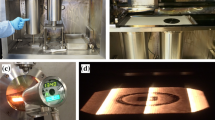Abstract
In this study, the effect of arc mode in cold metal transfer (CMT) process on the porosity characteristic of additively manufactured Al-6.3%Cu alloy has been systematically investigated. The variants include conventional CMT, CMT pulse (CMT-P), CMT advanced (CMT-ADV) and CMT pulse advanced (CMT-PADV) and experiments were performed on both single layer deposits and multilayer deposits. The mechanism of porosity generation using the CMT arc mode variants is discussed. It was found that deposit porosity is significantly influenced by the arc mode type of CMT process. Conventional CMT is not suitable for the additive manufacturing process because it produces a large amount of gas pores, even in single layer deposit. CMT-PADV proved to be the most suitable process for depositing aluminium alloy due to its excellent performance in controlling porosity. With correct parameter, setting the gas pores can be eliminated. It was found that the key factors that enable the CMT-PADV process to control the porosity efficiently are the low heat input, a fine equiaxed grain structure and effective oxide cleaning of the wire.
Similar content being viewed by others
References
Ding J, Colegrove P, Mehnen J, Ganguly S, Sequeira Almeida PM, Wang F, Williams S (2011) Thermo-mechanical analysis of wire and Arc additive layer manufacturing process on large multi-layer parts. Comp Mater Sci 50:3315–3322
Wang F, Williams S, Colegrove P, Antonysamy AA (2013) Microstructure and mechanical properties of wire and arc additive manufactured Ti-6Al-4 V. Metall Mater Trans A 44A:968–977
Wang HJ, Jiang WH, Ouyang JH, Kovacevic R (2004) Rapid prototyping of 4043 Al-alloy parts by VP-GTAW. J Mater Process Technol 148:93–102
Ouyang JH, Wang HJ, Kovacevic R (2002) Rapid prototyping of 5356-aluminum alloy based on variable polarity gas tungsten arc welding: process control and microstructure. Mater Manuf Process 17:103–124
Liu WL (2007) Rapid prototyping technology of Al-alloy parts by AC-TIG. Tianjin University, Tianjin
Buchbinder D, Schleifenbaum HB, Heidrich SB, Meiners WB, Bültmann J (2011) High power selective laser melting (HP SLM) of aluminum parts. Phys Procedia 12:271–278
Brandl E, Heckenberger U, Holzinger V, Buchbinder D (2012) Additive manufactured AlSi10Mg samples using selective laser melting (SLM): microstructure, high cycle fatigue, and fracture behavior. Mater Des 34:159–169
Feng JC, Zhang HT, He P (2009) The CMT short-circuiting mental transfer process and its use in thin aluminum sheets welding. Mater Des 30:1850–1852
Pickin CG, Young K (2006) Evaluation of cold metal transfer (CMT) process for welding aluminum alloy. Sci Technol Weld Joi 11:583–585
Pickin CG, Williams SW, Lunt M (2011) Characterization of the cold metal transfer (CMT) process and its application for low dilution cladding. J Mater Process Technol 211:496–502
Cook GE, Eassa EH (1985) The effect of high-frequency pulsing of a welding arc. IEEE Trans Indust Appl 1A–21:1294–1299
Pépe N, Egerland S, Colegrove P, Yapp D, Leonhartsberger A, Scotti A (2011) Measuring the process efficiency of controlled gas metal arc welding processes. Sci Technol Weld Joi 16:412–417
Dupont JN, Marder AR (1995) Thermal efficiency of arc welding processes. Weld J 12:406s–416s
Kamal P, Surjya KP (2011) Effect of pulse parameters on weld quality in pulsed gas metal arc welding: a review. J Mater Eng Perf 20:918–931
Kou S, Le Y (1986) Nucleation mechanisms and grain refining of weld metal. Weld J 65:305s–313s
Yunjia H, Frost RH, Olson DL, Edwards GR (1989) Grain refinement of aluminum weld metal. Weld J 68:280s–289s
Guo XM, Yang CG, Qian BN, Xu Q, Zhang HY (2005) Effects of inoculants Ti and Zr on the microstructures and properties of 2219 Al-Cu alloy welds. Acta Metall Sin 41:397–401
Xing JD (1993) Formation and prevention of gas pore in aluminum alloy. Spe Cast Nonfer Alloy 14:30–34
Shu D, Sun BD, Wang J (1998) Nucleation mechanism of gas pore in aluminum alloy. Found Eng 22:49–52
Xu LH, Tian ZL, Zhang XM, Peng Y (2006) Effects of shielding gas on microstructure and number of gas pore in high strength aluminum alloys weld. Trans Chn Weld Inst 27:69–72
Li KD, Chang E (2004) Mechanism of nucleation and growth of hydrogen porosity in solidifying A356 aluminum alloy: an analytical solution. Acta Mater 52:219–231
Kou S, Wang YH (1986) Weld pool convection and its effect. Weld J 3:63s–70s
Devletian JH, Wood WE (1983) Factors affecting porosity in aluminium welds—a review. WRC Bull 290:1–18
Li ZY, Zhu MF, Dai T (2013) Modeling of microporosity formation in an Al-7%Si alloy. Acta Metall Sin 49:1032–1040
Lee PD, Hunt JD (2001) Hydrogen porosity in directionally solidified aluminium-copper alloys: a mathematical model. Acta Mater 49:1383–1398
Sun JS, Wu CS (2002) The influence of heat input on the MIG weld pool behaviour. Sci Chn E 32:465–471
Lin ML, Eagar TW (1985) Influence of arc pressure on weld pool geometry. Weld J 64:162s–169s
Silva CLM, Scotti A (2006) The influence of double pulse on porosity formation in aluminium GMAW. J Mater Process Technol 171:366–372
Harwig DD, Dierksheide JE, Yapp D, Blackman S (2006) Arc behavior and melting rate in the VP-GMAW process. Weld J 3:52s–62s
Kumar R, Dilthey U, Dwivedi DK, Ghosh PK (2009) Thin sheet welding of Al 6082 alloy by AC pulse-GMA and AC wave pulse-GMA welding. Mater Des 30:306–313
Author information
Authors and Affiliations
Corresponding author
Rights and permissions
About this article
Cite this article
Cong, B., Ding, J. & Williams, S. Effect of arc mode in cold metal transfer process on porosity of additively manufactured Al-6.3%Cu alloy. Int J Adv Manuf Technol 76, 1593–1606 (2015). https://doi.org/10.1007/s00170-014-6346-x
Received:
Accepted:
Published:
Issue Date:
DOI: https://doi.org/10.1007/s00170-014-6346-x




